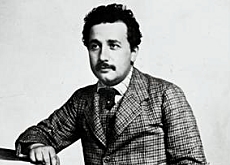Einstein’s home was window on the universe

The Albert Einstein museum has reopened in Bern, providing a glimpse of the scientist’s quiet but productive life in the Swiss capital.
It was exactly 100 years ago in this modest apartment in the city’s old town that Einstein churned out some of his most significant physics papers.
The unassuming building is just one of many along Bern’s Kramgasse and has an entrance that looks onto some of the city’s famous arcades.
Visitors have to climb two flights of steep, twisting stairs before reaching the small flat where Einstein made some of his groundbreaking discoveries.
The physicist moved to Bern in 1902 out of necessity, after failing to secure a teaching position in Zurich. He worked as a low-level – but extremely well paid – clerk in the Swiss Patent Office during the day, pushing the boundaries of science in his spare time.
The apartment at Kramgasse 49 is just one of nine places in which Einstein lived during his seven years in the capital. But it was there that he changed the face of modern physics in 1905 in what scientists refer to as his “miracle year”.
The papers he published that year still influence physics today, according to Gerd Grasshof, who teaches history of science at Bern University.
“In 2005 when you talk about cosmological structures and the physics of space and time, [Einstein’s theory of] general relativity is the standard approach,” he told swissinfo. “He still plays an enormous role.”
The scientist’s theories are also at work in more mundane ways. For example, Global Positioning Systems – or GPSs – used to pinpoint a place anywhere on the planet with satellites, only work properly thanks to the application of Einstein’s theory of relativity.
Time capsule
Einstein’s two-bedroom flat is one part of the city’s revamped Einstein museum. Visitors have to head up another flight of stairs for the second part, which is devoted to displays on the scientist’s life and works.
The flat has been restored to look very much like it did in his day. The walls are covered in memorabilia, as well as photos from his Bern period.
It could well be that the physicist penned some of his most famous works at a table just like the one that can be seen in the room overlooking the street.
“Our main interest was to present Einstein’s home as it would have really been,” said Barbara Bürki, who works for the museum. “We wanted to give people an idea of his living conditions.”
Bern was certainly the ideal workplace for someone like Einstein, who was a total stranger to the city, according to Bürki.
“It was a place where he felt at ease and where he did not have a lot of friends,” she told swissinfo. “He only needed a few acquaintances to share his ideas with and he didn’t have to spend too much of his energy on social contacts.”
Grasshof adds that Einstein’s job at the patent office allowed him the freedom to pursue his own ideas in his spare time, unshackled from academic considerations.
“He was able to set his own agenda,” said Grasshof. “If he had been hired as an assistant in a laboratory, he probably would have been forced to work on a subject of interest for the laboratory.”
Local interest
Before it closed for renovation work, the Einstein house attracted around 10,000 visitors annually and the museum’s management is hoping that even more will make the trip this year.
Bürki says that interest in Einstein has certainly increased in this centennial year – and not just among the tourists.
“Usually, foreigners constitute most of our visitors,” admits Bürki. “But this year, people from Bern and the local area have shown more interest in Einstein’s life and times than usual.”
There’s more to see in Bern than just the Einstein house. Since the beginning of the month a special trail has wound its way around the city, taking walkers to 88 points of interest marked out on a special map.
“You get a completely different picture of what the city might have been when Einstein was here 100 years ago,” said Grasshof. “But you can also visualise Bern in his time as many of the buildings from that period still exist.”
Obsession
Other events this year include the world’s biggest ever Einstein exhibition from mid-June at Bern’s Historical Museum. Visitors will able to see more of the life and times of the scientist, as well as discover some of the secrets of his science.
Culture and the arts haven’t been forgotten either. In October the National Library will be looking at Swiss author Friederich Dürrenmatt’s preoccupation with Einstein and physics, while the Bern Biennale art festival will be looking at the physicist’s relevance today.
The list of events stretches on. “Even the restaurant where Einstein used to have a drink is preparing something special,” said Bürki. “I think people are proud he lived here.”
Bern’s obsession with all things Einstein may seem to be going too far in a city that knew nothing of the genius in its midst while he lived there. But Bürki says that all the attention is positive.
“I think it is important to have someone to be proud of and he really deserves our devotion,” she told swissinfo. “I believe it goes far beyond people simply trying to cash in on a famous name.”
swissinfo, Scott Capper
Albert Einstein was born in Ulm, Germany, on March 14, 1879.
His family moved shortly afterwards to Munich, then to Italy and finally to Switzerland.
He continued his education in Aarau and in 1896 he entered Zurich’s Federal Institute of Technology to train as a maths and physics teacher.
In 1901 he became a Swiss citizen and a year later began working at Bern’s Patent Office.
In 1905 he produced five groundbreaking papers on theoretical physics.
In 1909 he took up a teaching position in Zurich and moved on to Prague in 1911.
Einstein died on April 18, 1955 in Princeton, New Jersey.

In compliance with the JTI standards
More: SWI swissinfo.ch certified by the Journalism Trust Initiative










You can find an overview of ongoing debates with our journalists here . Please join us!
If you want to start a conversation about a topic raised in this article or want to report factual errors, email us at english@swissinfo.ch.